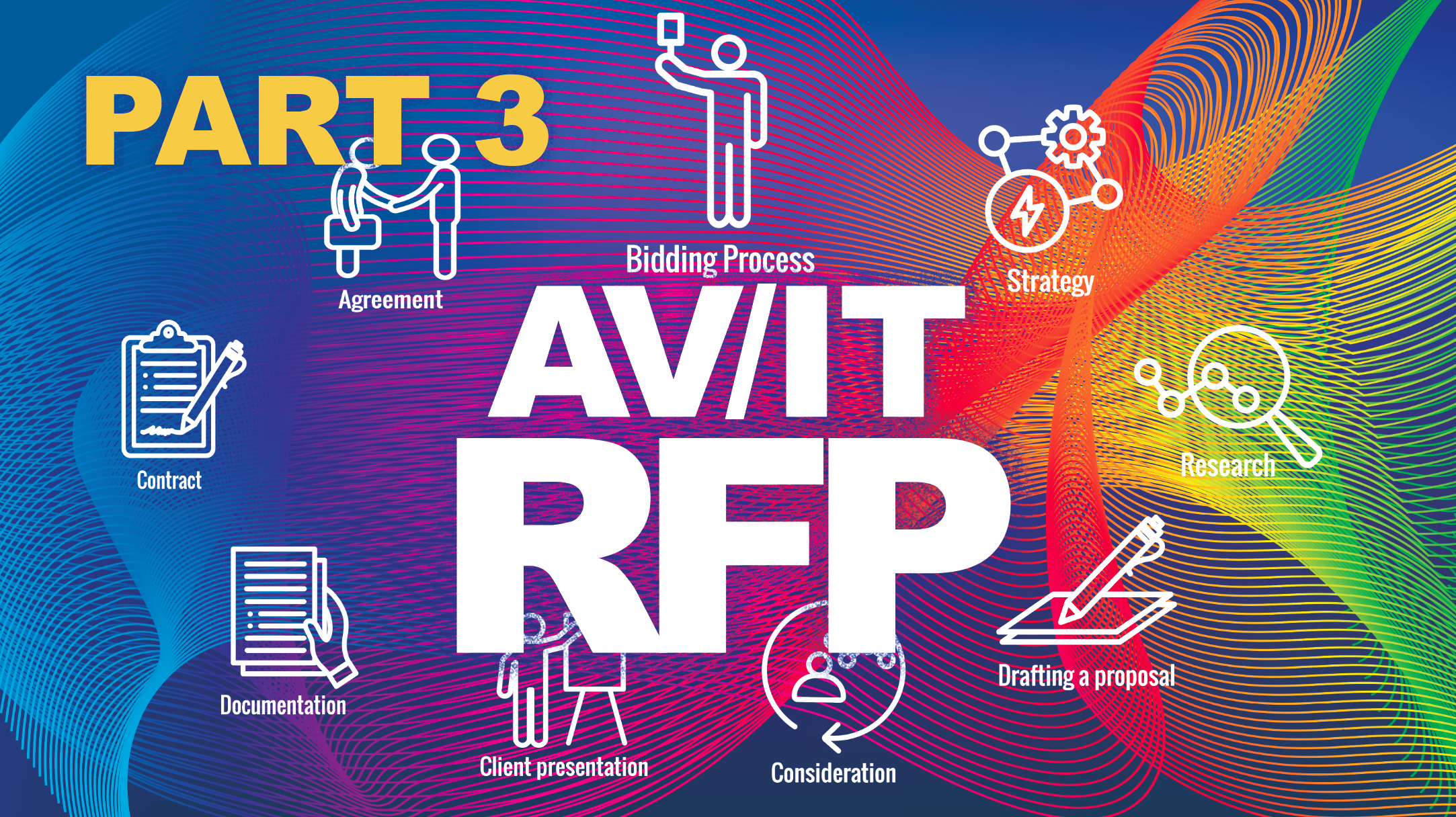AV Technology presents the five-part series of articles on Navigating a Successful Higher Ed AV/IT RFP Process, written by Joe Way, PhD, CTS, executive director of Digital Spaces at the University of California, Los Angeles’ Digital & Technology Services.
Are you currently creating an AV/IT Request for Proposals (RFP)? If so, start here!
Based on recent and past personal experience, Joe Way chronicles the step-by-step process of creating, executing, and implementing the AV/IT RFP.
Way said, “Institutions should view it [the RFP] as an opportunity to articulate their vision with clarity, while vendors should approach it as a chance to demonstrate alignment with that vision. The most successful outcomes happen when the RFP becomes a bridge that translates institutional goals into practical requirements, allowing bidders to respond with solutions that go beyond the minimum spec sheet.”
All five parts will be published within one week. Come back here to view the next one.
To introduce the article series, AV Technology’s Cindy Davis chatted with Joe Way and asked him about best practices and if there were any surprises while creating and implementing the AV/IT RFP. Check out the interview below.
Define the Parameters
Before beginning to draft an RFP, one of the most critical steps is ensuring that the project’s foundation is solid and aligned in four critical areas: budget, timeline, human resources, and scope. Too often, institutions rush into the writing process without confirming whether funding is truly secured or if the necessary resources are available to deliver. This leads to delays, confusion, and frustration for both the institution and bidding vendors. Establishing a firm-approved funding authorization (FAU) or equivalent financial confirmation ensures that when the RFP is released, the institution has the capacity to act on it. It is imperative to understand how funds will be accessed, distributed, and balanced. Nothing erodes trust faster with your vendor partners than issuing an RFP that cannot realistically be awarded or fails to provide funds when expected.
Equally important is the timeline. Vendors build their resource commitments, engineering schedules, and supply chain orders around the dates provided in the RFP. If those dates are vague or subject to constant revision, it introduces risk into the process and often inflates bids. Institutions should confirm internal approvals, construction schedules, and academic calendars before setting deadlines. A timeline grounded in reality not only produces more accurate proposals but also builds credibility with bidders, who can trust that their investment of time and effort is not wasted. Likewise, clearly documented milestone expectations allow institutions to hold the awarded party accountable for delivery of agreed-to services.
Human resources must also be mapped out in advance. This includes not only funding but also the human capital required to manage the project. Identifying a neutral product manager to oversee the entire process, the procurement and evaluation teams who will judge the RFP responses, and the project manager who will oversee the implementation once awarded, prevents bottlenecks later. Institutions that fail to plan resources often discover gaps midstream, forcing them to either stall the project or make rushed decisions. A well-prepared RFP signals to vendors that the institution is serious, organized, and ready to follow through. Also, it is important that all bid evaluators understand the time commitment and fully understand the judging rubric prior to bids being returned.
Finally, the scope must be carefully defined before the first line of the RFP is written. Scope creep is one of the most common reasons projects run over budget and behind schedule. By confirming in advance what is in scope and what is not, whether that means the number of rooms, specific technologies, or the level of integration, the institution provides vendors with the clarity they need to respond effectively. Together, budget, timeline, resources, and scope create a framework of accountability. When these are locked in before the RFP is drafted, the result is a process that respects both the institution’s mission and the vendor’s investment, leading to stronger partnerships and better outcomes.
Write It with Intention, Avoid Ambiguity
When it comes to writing the RFP itself, intentionality is everything. A well-crafted document does more than list technical requirements; it communicates vision, sets expectations, and creates a framework for meaningful responses. The goal is to eliminate ambiguity, invite innovation, and ensure that every proposal can be evaluated on an equal footing, based on the merit of each company. Done properly, it should eliminate all biases. Institutions that take the time to write with clarity, detail, and purpose not only make life easier for vendors but also increase their own chances of receiving solutions that truly align with their mission.
An RFP that lacks clarity produces nothing more than boilerplate replies. Vendors can only respond to what is written, so institutions must articulate their needs with precision. Want to know how many successful projects were performed like yours? Ask. What to know if they’ve ever done a gazillion-pixel video wall? Ask. Want to know exactly who will be assigned to your project, along with their resumes and credentials? Ask. This includes not only the scope of work but also the outcomes the project is expected to achieve. By spelling out instructional goals, pedagogical considerations, and desired user experiences, institutions empower vendors to craft responses that are meaningful and innovative, rather than generic and vague. The more detail provided up front, the more tailored and accurate the proposals will be. Likewise, outline exactly what is desired in a response. For example, rather than asking “describe your experience in higher education,” write “give three detailed examples of a similar project in higher education, noting budget, scope, solution selected, final outcome, challenges, wins, any case studies performed, and the contact information for the institutional contact who signed off on the project.” The more details asked, the more details the response, as well as the ability to hold the vendor accountable for the delivery of services.
Every project has core requirements that cannot be compromised. Whether it’s ADA accessibility, security standards, interoperability with existing systems, specific timelines aligned with class calendars, or adherence to campus-wide design guidelines, these non-negotiables must be clearly identified in the RFP, with a “must-haves” document. By separating must-haves from nice-to-haves, institutions allow vendors to prioritize their solutions appropriately. This transparency also helps streamline evaluation: if a proposal fails to meet any of the non-negotiables, it can be quickly eliminated from consideration, saving time for both the institution and the vendor. The more innovative the project, or the more specific skillsets are required to execute the project, the more important the “must-haves” are. If the project is immersive AR/VR or esports, but the vendor has never done any work in that realm, it is best to know upfront.
Technical specifications are important, but they rarely reveal how a solution will improve teaching and learning or bring added value to the project or institution. RFP questions should therefore be designed to elicit more than a “yes” or “no” response. Instead of asking whether a system supports a feature, ask vendors to describe how that feature contributes to usability, sustainability, or instructional outcomes. Open-ended prompts invite vendors to differentiate themselves by showcasing creativity, highlighting unique strengths, and aligning their solutions to the institution’s vision. This not only surfaces hidden value but also fosters a spirit of collaboration rather than compliance.
One of the most practical tools an institution can provide is a sample bill of materials (BOM) assignment. This doesn’t lock the project into specific equipment but instead serves as a baseline for comparison. By including a representative list of products, quantities, and specifications, institutions ensure that all bidders are working from the same assumptions. Asking the vendor to price out the BOM along with the labor costs to install levels the playing field and minimizes “apples to oranges” proposals that make evaluation difficult. A sample BOM also gives bidders the flexibility to propose alternatives where appropriate, while maintaining alignment with the overall design intent. Hint: Consider intentionally adding an error, like a part number no longer manufactured, mismatched quantities, or products that do not work with one another, as a test.
Few things frustrate vendors more than chasing opportunities without a clear financial or scheduling framework. Providing a realistic budget range, broken down for each aspect of the project, sets expectations and allows vendors to tailor their proposals accordingly. Similarly, outlining the project timeline, including how long it will take to complete the RFP process, milestones for review, installation windows, and commissioning deadlines, enables bidders to plan resources and supply chain logistics with confidence. Transparency in budget and timeline does not weaken an institution’s negotiating position; rather, it builds trust and ensures that proposals are both achievable and aligned with institutional priorities. In fact, if the budget is $1,000,000, for example, tell them. Don’t waste anyone’s time and hope that they come in lower. I’ve heard colleagues say that if they let bidders know the budget, the vendors will just make sure to spend it all. I challenge that and argue that by being transparent, you can discover which vendors are able to bring more value within the budget constraints. Likewise, if there is a tight timeline, be upfront. Supply chain may require added expedited shipping costs or overnight teams in order to execute. Honesty upfront helps to mitigate against change orders and budget surprises later.
An RFP is the institution’s opportunity to gather the full picture, so it should ask every question necessary to make an informed decision. If differentiators matter, be explicit in requesting them. If innovation is a priority, include prompts that encourage vendors to share creative approaches, pilot ideas, or forward-looking solutions. If certifications like CTS are essential, ask for details about the qualifications of the team that will actually deliver the project. The more intentional and specific the questions, the more meaningful and actionable the responses will be.
Note: The views and opinions expressed in this article are solely those of Josiah Way himself, speaking in his personal capacity as an industry professional. They do not represent the positions, policies, or endorsements of UCLA, UC Regents, HETMA, Higher Ed AV, or any of Josiah Way’s affiliated institutions or organizations. Nothing contained herein should be interpreted as a promise, guarantee, or commitment regarding current or future business relationships, procurement decisions, or bid outcomes. The content provided reflects general industry best practices and professional perspective gained through personal experience only and should not be construed as binding guidance or official policy.

